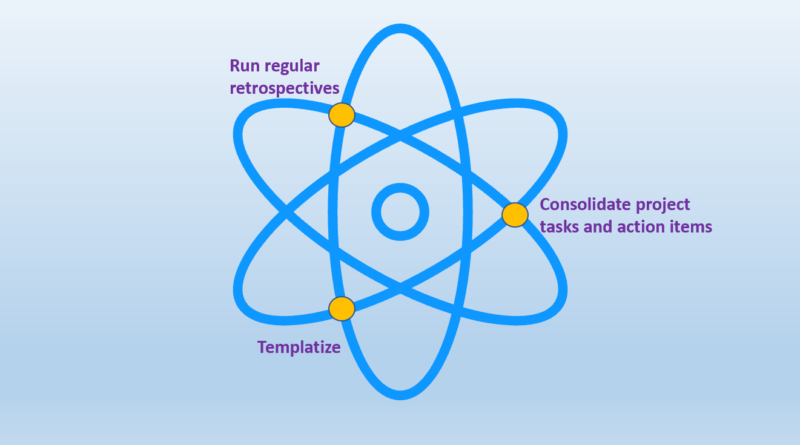3 Atomic Habits for Program Managers
Atomic Habits has been on Amazon’s top 20 most read books of the week for 167 weeks. In his book, James Clear proposes a four-step model of habits and the four laws of behavior change:
- Cue – Make it obvious.
- Craving – Make it attractive.
- Response – Make it easy.
- Reward— Make it satisfying.
Here are a few book excerpts that form the foundation for this blog entry:
“What is rewarded is repeated. What is punished is avoided. The first three laws of behavior change—make it obvious, make it attractive, and make it easy—increase the odds that a behavior will be performed this time. The fourth law of behavior change—make it satisfying—increases the odds that a behavior will be repeated next time. It completes the habit loop.”
“Success is the product of daily habits—not once-in-a-lifetime transformations. Habits are the compound interest of self-improvement. “
James Clear
What can we take away from this? Here are three habits that I strongly recommend program managers implement. These are proven techniques that will help regardless of the type and size of the projects/programs:
Atomic Habit #1: Run regular retrospectives
Retrospectives are an excellent way to identify incremental improvements on a continual basis. Continuous improvement is also the foundational concept of Kaizen. Retrospectives are built into the Scrum methodology; however, you can use retrospectives irrespective of the methodology. Here are some steps to build this habit of running regular retrospectives:
- Make it obvious by scheduling a recurring retrospective on your team’s calendars (biweekly, monthly or whatever cadence works for your project team).
- Make it attractive by varying the format of the retrospectives regularly. Example: Use some fun templates for running retrospectives. There are several formats and templates that you can find on the internet.
- Make it easy by allocating 10 minutes at the start of the retrospective to add everyone’s thoughts into the retrospective template. Identify only one improvement that is easy to implement.
- Make it satisfying by starting off the retrospective by sharing the results of the improvement that you have implemented from the last session. Another way to make it rewarding is to add a “Thanks to…” section in the retrospective, where participants give thanks to the team members that helped them out
Atomic Habit #2: Templatize
“Templatize” as many artifacts like status reports, requirements documents, design documents and strategy documents as possible. While some leaders believe that templates limit creativity, I strongly believe that it is not the best use of our time to start everything from scratch when there are already well-established and researched templates. Creating an initial set of templates is a one-time cost with huge benefits in the long run. Get your project teams into the habit of using templates:
- Make it obvious by creating a shared repository of all the templates and publicize the location of the templates widely. Make it part of a new project team member onboarding guide, project information resources page, etc.
- Make it attractive by creating templates that are not only visually appealing, but also follow the accessibility guidelines. We don’t need to go overboard in terms of visual appeal, but ensure they meet the minimum standards for your team/company. Additionally, have an influential team member start using these templates. People form habits by imitating others, and having an influential team member using them would be a good way to get them motivated.
- Make it easy to create the artifacts from the templates by providing as few instructions as possible. Also give them the freedom to make changes to the artifact based on the specific need without any approval process.
- Make it satisfying by recognizing the team members that use the templates to create their artifacts. This is needed in the initial stages when the team members are getting into the habit of using the templates.
Another advice from the book is “standardize before you optimize” and this is perfectly applicable for templates. Standardize the use of templates first and based on the patterns that emerge, optimize the templates
Atomic Habit #3: Consolidate project tasks and action items
One of the challenges I have been facing has been that the action items from meetings are all over the place (Google docs, Words docs, Excel docs, etc.) and the project tasks are typically tracked in a tool (Jira, Asana, Monday.com, etc.). Consolidating project tasks and action items would greatly simplify tracking both for the PM and the team. Here is a suggestion to get the team into the habit of adding action items to the task tracker:
- Make it obvious by creating a specific section in the task tracking tool for tracking meeting agendas and action items. I have added a section called “weekly stand ups” in our regular project tracker and started adding agenda topics and action items there. You would have to figure out the best way to do this with the specific task-tracking tool that you use.
- Make it attractive by using the features that the tracking tools already have for creating dashboards to show items in progress, completed, etc. Several contemporary task-tracking tools have the ability to create very attractive dashboards.
- Make it easy by using existing tools and creating a section in the same task tracker so that the team has one place to check all their tasks and action items.
- Make it satisfying by recognizing and acknowledging the completed action items and tasks. Send out weekly reports. Recognize team members that diligently use the tracker.
In summary, here are my top three atomic habits that you can cultivate amongst your project/program teams for success over the long term:
- Run regular retrospectives
- Templatize
- Consolidate project tasks and action items
I would love to hear the habits that have helped you as a program manager. Share them in the comments below!
Also published at projectmanagement.com
